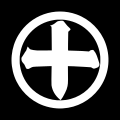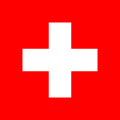十字

この項目「十字」は途中まで翻訳されたものです。(原文:en:Cross) 翻訳作業に協力して下さる方を求めています。ノートページや履歴、翻訳のガイドラインも参照してください。要約欄への翻訳情報の記入をお忘れなく。(2010年6月) |
十字(じゅうじ、クロス、英:cross)とは幾何学図形の1つで、2つの線(棒)が互いに直角に交差して、片方または両方の線が中央で分割されている。線は通常は水平と垂直だが、斜めの場合は斜め十字(ななめじゅうじ、サルタイアー、英:saltire、聖アンデレ十字)とも呼ばれる。
なお日本では、線が垂直な場合は漢字の「十」と同じ形のため「十文字」(じゅうもんじ)、斜めの場合は「×」(バツ、ペケ)と呼ばれる事もある。
概要
十字は最も古代から存在する人類のシンボルの1つであり、多くの地域で使用されている。キリスト教の十字架の他、世界の四大要素や方位(Chevalier, 1997)、あるいは縦線を神性、水平線を世界とした統一概念の象徴など(Koch, 1955)として使われている。
現代でも多数の国旗、赤十字社などの標章や紋章、家紋などにも使用されている。なお中国の、晋の時代に十字をつけた餅を食して厄除けとする風習が、日本に伝えられると鎌倉時代に流行し、その餅のことを「十字」といったともされる[1]。
標章やシンボルの例
| 名前 | 説明 | 画像 |
|---|---|---|
| ラテン十字 |
横木が縦木より短く、横木が縦木のやや上方に直角に付くのが特徴。 |

|
| アンク(取っ手付き十字 エジプト十字)
/ Ankh |
Also known as the Key of the Nile, the Looped Tau Cross, and the Ansated Cross. It was an Ancient Egyptian symbol of life and fertility. Sometimes given a Latin name if it appears in specifically Christian contexts, such as the crux ansata ("handled cross"). |

|
|
/ Coptic ankh |
The Coptic ankh is the Ankh related pre Original Coptic cross of the early Gnostic Christians in Egypt. |

|
|
/ Original Coptic Cross |
The original Coptic cross used by early Gnostic Christians in Egypt. |

|
| 太陽十字 |
Also known as the Sunwheel, solar cross or Odin's cross, because Odin's symbol in Norse mythology was a cross in a circle. Used throughout Native American culture to represent the great Medicine Wheel of life. It's also the symbol used by the Gnostic Movements. |

|
| ケルト十字 |
ラテン十字と十字の交差部分を囲む輪から構成される。十字のところに複雑な装飾があるのが伝統的なもの。 |

|
| コプト十字
/ Coptic Cross |
A small circle from which emanate four arms of equal length, with angled T shapes in the corner, cross-pieces outward, representing the nails used in Jesus' crucifixion. This cross receives its name from Coptic Christianity, which centered around Alexandria, Egypt. |

|
| カンタベリー十字 |
聖公会(英国教会系)で使われている。中央から同じ長さの4つのアームが出ていて、外側にゆくに従い太くなって、ハンマーのようになり、それは外側で全体的に円形になるようなユニークな形をしている。各アームは三角形にも見えて、これは三位一体をシンボル化しているといわれる。中央には小さな四角がある。この十字は1867年にカンタベリーの道路の下からブローチとして発見され、紀元850年にアングロサクソン族がもたらしたと思われる。石作りのレプリカはカンタベリー大聖堂においてあり、世界の聖公会教会で見かける。ここに詳しく記述がある(英語)。 |

|
| ギリシャ十字 |
縦木と横木が等しい長さで、中央で交差するのが特徴。 |

|
| 八端十字架 |
8つの端を持つためにこの名がある。ラテン十字に2本、横木が書き加えられた形状をしている。 書き加えられた2本ともラテン十字の横木より短く、うち1本はラテン十字の横木より上に平行に、もう1本はラテン十字の横木よりかなり下に左上右下になるように、書き加えられている。 |

|
| 聖ブリジッドクロス |
This cross is found throughout Ireland. It is told that the cross was made by Brigid, daughter of a Pagan King from reeds to be used as an instrument of conversion. However, Brigid's name is derived from Brigit (also spelled Brigid, Brìghde, Brìde, and Bríde), a Celtic Goddess of fire, poetry, and smithcraft, and today the cross is used to protect houses from fire. This is an example of the integration of religious traditions. The cross itself derives from the Indo-European Swastika, or Solar Wheel |

|
| ラバルム
/ Labarum |
ギリシア文字のΧ(カイ)とΡ(ロー)を組み合わせた形状。 |

|
| ロレーヌ十字 |
縦棒1本とそれに直角に交差する横棒2本からなる。2本の横棒の間隔は等しい。現代で一般的なものは下の棒が上の棒より長く、そのため総主教十字と似ている。 |

|
|
/ Macedonian Cross |
A christian cross, firsly discovered in 2006 in churches in several locations in the Republic of Macedonia. |
ファイル:Macedonian Cross.png |
|
ラテン十字を、右下の空白が大きくなるように縦木と横木をずらし、右下の空白に「M」と記した形状。 |

| |
| スカンディナヴィア十字 |
左側に交点が寄った横長の十字。デンマークの国旗を基にしたもの。北欧諸国の国旗などに使われている。 |

|
| オクシタニア十字 | 
| |
| 教皇十字 |
The three cross-bars represent the Pope's triple role as Bishop of Rome, Patriarch of the West, and successor of St. Peter, Chief of the Apostles. |

|
| 総主教十字 |
Similar to a traditional Christian cross, but with an additional, smaller crossbar above the main one meant to represent all the Orthodox Christian Archbishops and Patriarchs. In the Eastern Orthodox Church, this cross is sometimes seen with an additional, slanted bar near the foot of the cross (see Byzantine Cross). This cross is similar to the Lorraine Cross and the Caravaca Cross. |

|
| 長老派教会の十字
/ Presbyterian Cross |
長老派教会で用いられている。 | 
|
| 赤十字 |
スイスの国旗の色を反転させたものであり、赤十字は赤十字社によって使用され、世界の多くの地域で医療・治療のシンボルとなっている。イスラム教地域では、同様に赤新月社の赤い月が使用され、イスラエルではマーゲン・ダビド公社の赤いダビデの星が使われる。 |

|
|
A Latin cross with a superimposed sword, blade down. It is a symbol used by the Commonwealth War Graves Commission at the site of many war memorials. |

| |
| グルジア国旗の十字 | 
| |
| 葡萄十字 |
横木が、やや下へ垂れ下がっているのが特徴。 |

|
| 聖トマスの十字 |
Also known as a "Mar Thoma Cross" and traditionally ascribed to Saint Thomas,the Apostole of India, it is used as a symbol of the Syro Malabar Catholic Church and venerated by all Saint Thomas Christians denominations. |
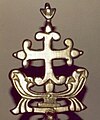
|
| 聖アンデレ十字 |
X字形で、白地に青、又は青地に白の十文字。特に旗の名前としても有名。 |

|
| 聖ゲオルギウス十字 |
イングランドの国旗として使用。 |

|
| 聖パトリキウス十字 |
イギリスの国旗の中でアイルランドを意味する旗として使用。 |

|
| 聖ペトロ十字 |
ラテン十字を上下逆にした形状。そのため「逆十字」ともいわれる。 |

|
| 髑髏と骨 |
Not a cross as such, but a saltire made of bones, with an overlaid skull. While traditionally associated with pirates, it was actually relatively rarely used by them, each ship having its own design, often involving an hourglass. |

|
| タウ十字 |
Also known as Saint Anthony's Cross, the Egyptian Cross and the crux commissa. It is shaped like the letter T. Francis of Assisi used it as his signature. |

|
| フォーク十字 |
Also known as the Furka Cross. The fork, shaped like the letter Y. [1] |
|
| 錨十字 |
The Mariner's Cross is a stylized cross in the shape of an anchor. The Mariner's Cross is also referred to as St. Clement's Cross in reference to the way he was martyred. |

|
| Order of Christ Cross |
Cross originally used by the Portuguese Order of Christ. Since then it has become a symbol of Portugal, used on the sails of the carracks during the Discoveries Era, and currently by the Portuguese Air Force. |

|
| Extreme-right variant of the Celtic Cross |
Some white nationalist and neo-fascist groups adopted this variation of the Celtic cross, made up of simple lines, without any of the ornamental complexity of traditional Celtic crosses. It is thought that this basic variation's minor resemblance to the swastika[要出典] is the reason it has become popular in such circles. |

|
| マルタ十字 | 4つのV形をした紋章がその底部で結合した形をしており、突き出た8つの角を持つのが特徴。 | 
|
| エルサレム十字 |
A variant of the Crusaders' cross with cross potent. It is also the logo for the Knights and Dames of the Holy Sepulcher of Jerusalem as well as the Franciscan order's Custody of the Holy Land. The Kairos retreat bestows this cross on its participants. |

|
| クローバー十字
/ Cross bottony |
A cross with the ends of the arms bottony (or botonny), i.e. shaped like an architectural trefoil. It occurs counterchanged on the flag of Maryland. | |
| 十字軍十字
/ Crusaders' cross |
Also known as the Jerusalem cross. This cross was the symbol of the Crusader Kingdom of Jerusalem, which existed for almost two hundred years after the First Crusade. The four smaller crosses are said to symbolize either the four books of the Gospel or the four directions in which the Word of Christ spread from Jerusalem. Alternately, all five crosses can symbolize the five wounds of Christ during the Passion. This symbol is also used in the flag of Georgia. | |
| 洗礼十字
/ Baptisma cross |
ギリシャ十字にキリストの頭文字Xを重ねた十字。プロテスタントのバプティスト派で用いられる。 |
紋章の例
以下は紋章の中でも十字を主要または専用に使用した例で、必ずしも十字の特別な意味を持つものではない。以下は十字の紋章の全てではなく、よく知られている例である。
| 画像 | 十字の名称 | 説明 |
|---|---|---|

|
一般的な紋章十字 / heraldic "ordinary" |
追加の用語の付かない単純な「紋章十字」は、アームはほぼ同じ長さで、盾の特別な姿に芸術的な均衡を持ち、盾の端まで伸びている。画像は「Azure, a cross Or」の紋章記述で、青い盾に金の十字の例である。盾の端まで伸びていない十字は、紋章用語で「couped」や「humetty」と呼ばれる。 |

|
クロス・アンキー |
碇の形をした十字。クロス・アンキー(Cross anchry)、アンカード・クロス(Anchored cross)、マリナーズ・クロス(Mariner's cross)などと呼ばれる。 |

|
クロス・バービー |
クロス・バービー(Cross barbée または cross barby)やアロウ・クロス(arrow cross、矢十字)と呼ばれ、両端が同じ形の2つの矢が十字なっている。今日では1930年代のファシストの矢十字党が使用したことで知られているが、中世のハンガリーの部族で使われていた。キリスト教徒による使用では、十字の端は魚の釣り針やもりの戻しに似ている。これはキリストのイクトゥスのシンボルや、福音書の「魚釣りの男」を暗示している。 |

|
クロス・ボトニー |
アームの端がボトニー(葉)の十字で、芸術的にtrefoilの形をしたものもある。メリーランド州の州旗でも使用されている。 |
| Cross cercelée |
アームの端が開いている十字で、羊の角のように両側に同じように丸くターンしている。 | |

|
クロス・クロスレット(Cross crosslet) |
アームの端が十字になっている十字。 |

|
クロス・フローリー(Cross flory, Cross fleury) | |

|
Cross fourchee |
One form of the heraldic cross fourchee (fourchée, fourchy) or cross fourche (meaning "forked"). |
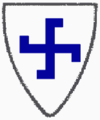
|
Fylfot |
Upright cross with truncated bent arms; essentially a variant of the swastika. |

|
Jerusalem cross |
Also known as the Crusader's Cross. This cross was the symbol of the Crusader Kingdom of Jerusalem, which existed for almost two hundred years after the First Crusade. The four smaller crosses are said to symbolize either the four books of the Gospel or the four directions in which the Word of Christ spread from Jerusalem. Alternately, all five crosses can symbolize the five wounds of Christ during the Passion. This symbol is also used in the flag of Georgia. It is also the logo for the Knights and Dames of the Holy Sepulcher of Jerusalem as well as the Franciscan order's Custody of the Holy Land. Many retreats including the Ignatian Kairos Retreat, and the Marian L.I.F.E. retreat bestow this cross on its participants as a sign of shared spirituality. |
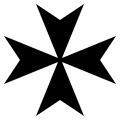
|
Maltese cross |
With arms which narrow towards the center, and are indented at the ends. The "eight-pointed cross" (with no curved lines). This is the basis for the US Marine Corps Sharpshooter badges. |

|
Cross moline |
In a cross moline, the ends of the arms are split and curved back. |

|
Cross patonce |
A cross patonce is more or less intermediate between a cross pattée and a cross flory (or fleury). |

|
Cross pattée |
A cross pattee (pattée, patty), or formée (formy) has arms narrowing towards the centre, but with non-indented ends. See also Iron Cross. This form is also used as the base for US Army Marksmanship badges. |

|
Cross pommee |
A cross pommee (pommée, pommy) has a circular knob at the end of each arm. |

|
Cross potent |
This cross has a crossbar at the end of each of its arms. "Potent" is an old word for a crutch, and is used in heraldic terminology to describe a T shape. It is used by many, mostly Roman Catholic, Scouting and Guiding organisations in their logos and insignia. |

|
Cross quadrate |
A cross with a square at the intersection point. |

|
Cross triple parted and fretted |
In heraldry, a "cross triple parted and fretted" (or "treble parted and fretted") is interlaced. Here, a version which is "Or on an Azure field" (gold on blue) is shown. |

|
Cross voided |
A "cross voided throughout", also known as the Gammadia, can be seen as a Greek cross with its centre lines removed, or as composed of four angles (L shapes) separated by a thin space. So the name "gammadia" refers to its being made up of four shapes similar to a capital Greek letter gamma. (The word gammadion can also refer to a swastika.) |

|
Cross fitchy |
A cross fitchy is a variation where the lower part is fashioned as a spike or sword blade, perhaps to plant the cross in the ground as a worshipping aid when its carrier stopped to worship where there was no church or chapel. This can be combined with other variations, e.g. cross crosslet fitchy, shown here. |

|
Cross of St James |
The Cross of St. James, similar to a Cross Flory Fitch, is formed by a Cross Flory, where the lower part is fashioned as a sword blade (fitched)—making this a cross of a warrior. It is most frequently depicted in red. (The version depicted here is the one used by the order of Santiago.) |
紋章における十字は、他にも非常に多くのバリエーションがある。紋章の背景知識は紋章学を参照。
有名なオンライン情報には A Glossary of Terms Used in Heraldry by James Parker (1894) があり、紋章における十字のバリエーションについて多くの情報が参照できる。
家紋の例
十文字紋(じゅうもんじもん)は、漢字の「十」を図案化した家紋である。図案には「丸に十文字」「島津十文字」、「日置十文字」、「猪飼十文字」などがある。その形状から、久留子紋と混同されることが多く、また、島津氏が用いたとされる「丸に十字」は轡紋と混同されることがある。
鎌倉時代初期の、島津忠久の甲冑に記された「十文字」が現存では最古の例である。主に島津氏とその関係の氏族が用いた。徳川幕府によるキリスト教の禁教令発布後は轡紋(くつわもん)、祇園守紋(ぎおんまもりもん)、桛紋(かせぎもん)、卍紋などとともに久留子紋の代用として用いられることがあった。[1]
-
丸に十文字
-
丸に十字
-
丸に十字(丸に十字久留子)
-
島津十文字
旗の例

いくつかの旗は十字を含んでいる。
北欧のスカンディナヴィア諸国の全ての国の国旗は、スカンディナヴィア十字で知られている(スウェーデンの国旗、アイスランドの国旗など)。17世紀以降のスイスの国旗は同じ長さの線による正方形の十字を使用し、赤十字の標章の元となった。ヨーロッパ以外でも キリスト教徒の多い国が、国旗に十字を入れることがある(トンガの国旗、 ジャマイカの国旗など)。
また南半球の多くの国は、国旗に南十字星(サザンクロス)を使用している(サモアの国旗 、ブラジルの国旗など)。
国旗の例
国旗以外の例
参照
- Chevalier, Jean (1997). "The Penguin Dictionary of Symbols". Penguin ISBN 0140512543
- Koch, Rudolf (1955). The Book of Signs. Dover, NY. ISBN 0-486-20162-7.
- Drury, Nevill (1985). Dictionary of Mysticism and the Occult. Harper & Row ISBN 0060620935
- Webber, F. R. (1927, rev 1938). Church Symbolism: an explanation of the more important symbols of the Old and New Testament, the primitive, the mediaeval and the modern church. Cleveland, OH. OCLC 236708.
関連項目
- ギリシャ十字
- ラテン十字
- 聖ペトロ十字(逆十字)
- T字
- 卍
- 十字架
- 赤十字
- 緑十字
- 黒十字
- 鉤十字
- 鉄十字
- 八端十字架(ロシア十字)
- 葡萄十字
- 十字軍
- 南十字星
- プラス記号とマイナス記号
- 短剣符
- クロス (紋章学)
外部リンク
- The Christian Cross of Jesus Christ: Symbols of Christianity, Images, Designs and representations of it as objects of devotion
- Seiyaku.com, all Crosses
- Lutheransonline.com, variations of Crosses - images and Mmeanings
- Nasrani.net, Indian Cross
- Freetattoodesigns.org, The Cross in Tattoo Art

